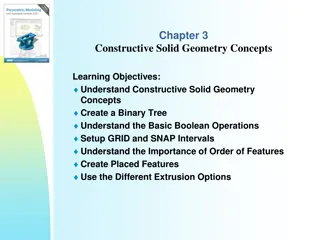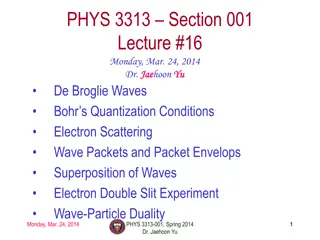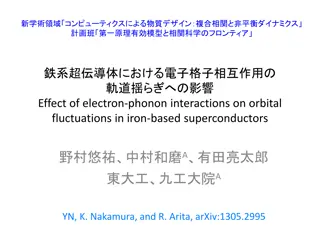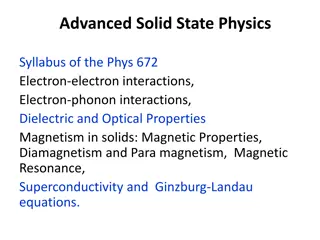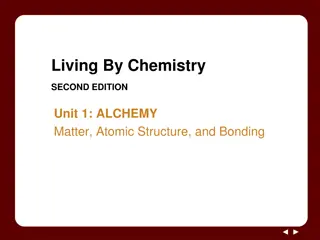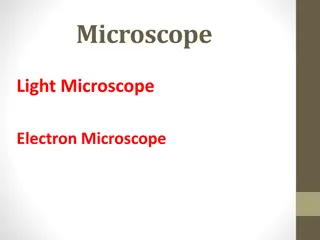Exploring the Free Electron and Nearly Free Electron Models in Solid State Physics
The Free Electron Model postulates that electrons in metals move freely without interacting with crystal ions, yielding insights on conductivities. Developed by Arnold Sommerfeld, it combines the Drude model with quantum mechanics. Conversely, the Nearly Free Electron Model leans on quantum mechanics to describe electron behavior within a solid's crystal lattice.
Download Presentation

Please find below an Image/Link to download the presentation.
The content on the website is provided AS IS for your information and personal use only. It may not be sold, licensed, or shared on other websites without obtaining consent from the author. Download presentation by click this link. If you encounter any issues during the download, it is possible that the publisher has removed the file from their server.
E N D
Presentation Transcript
Solid state physics Lecture (2) Nearly free electron model Prof. Dr. Wisam J. Aziz
Contents Free electron model. Nearly free electron. Kronig - Penney model. Tight-binding models. Band theory.
Free electron model The free electrons model is assumes that the electrons are weakly bonded to their atoms and move within the metal freely without being affected by the presence of atoms of matter and not interact with crystal ions. In another expression the free electron model is a simple model for the behavior of valence electrons in a metallic solid.
Free electron model was developed by Arnold Sommerfeld who combined the classical Drude model with quantum mechanical Fermi - Dirac statistics and hence it is also known as the Drude-Sommerfeld model. In the free electron model, there is neither lattice, nor electron-electron interaction, but it gives good result on electron specific heat, electric and thermal conductivities Free electron model is most accurate for alkali metals
Free Electron Model Some successes: 1. electrical conductivity =??2? ? 2. heat capacity ??=?2 ??? ??n?? 2 3. thermal conductivity Q= ?2 ?? ? ??? ?? 6
Successes of Free Electron Model Temperature dependence of Heat Capacity paramagnetic (Pauli) susceptibility Ratio of thermal and electrical conductivities (Lorentz number) Magnitudes of heat capacities and Hall effect in simple metals Failures of free electron model Heat capacities and Hall effect of many metals are wrong Hall effect can be positive Does not explain why mean free paths can be so long Does not explain why some materials are metals, some insulators and some are semiconductors
Nearly free electron model In solid state physics, the nearly free electron model (or NFE model) is a quantum mechanical model of physical properties of electron that can move almost freely through the crystal lattice of a solid. The model is closely related to the more conceptual empty lattice approximation.
Simple approximation: treat electrons as free to move within the crystal Atomic s-electrons are delocalized due to overlap of outer orbits. Crystal looks like positive ion cores of charge + e embedded in a sea of conduction electrons Conduction electrons can interact with each other and ion cores but these interactions are weak
Nearly free electron The origin of energy gap in nearly free electron The two standing waves ?(+) and ? pile up the electrons at different regain so the two waves have different values of potential energy in the filed of ion cour of the lattice. ?(+)= exp(??? ?) + exp( ??? ?) exp( ??? ?) = 2cos(?? ?) = 2isin(?? ?) . ?( )= exp(??? ?) .
Nearly free electron The electron constriction for standing waves ? ?(+) and ? ?( ) and of traveling waves.
The different between Free electron and nearly free electron
Comparison Nearly free e- s + pseudopotential Tight-binding Electrons nearly free .e- s tightly bound to nuclei Wave functions approximated by Linear combination of atomic plane waves wave functions Electrons in conduction band are Valence electrons are delocalized, so can be concentrated mainly in the approximated well by nearly free bonds and so they retain more electrons of their atomic character.
Tight-binding models Tight-binding models are effective tools to describe the motion of electrons in solids. Here, we assume that the system is a discrete lattice and electrons can only stay on the lattice site. The kinetic energy is included by allowing electrons to hop from one site to another.
Band theory Band theory suppose the crystal of matter have two bands:- (1)Valance band: contain valance electrons, and it never be empty. (2)Conduction band: contain conduction electrons. And between them hole or gap called: *Forbidden energy gap. Its size depends on the type of material conductive, semiconductor or insulating
Band theory Valance band:- Is the last envelope of the atom, which contains the electrons called valence electrons. Conduction band:- It is located above the Valance band and separated by the Forbidden energy gap, which contains the electrons called conduction electrons.
Band Diagram Conduction band Allow ed state s Forbidd en band gap 2 2 2 1 1 k d E dk = = E 2 2 2 * m * m Allow ed state s Valence band
Band theory Band theory classified the matter the types: 1. insulator, forbidden gap 6 eV 2. semiconductor, forbidden gap (0.1-6 eV) 3. conductor, forbidden gap 0.1 eV






